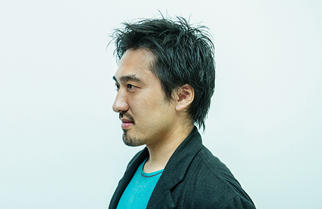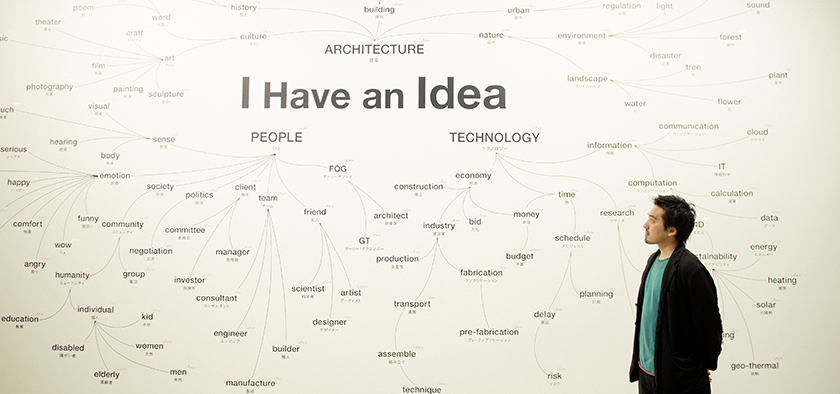
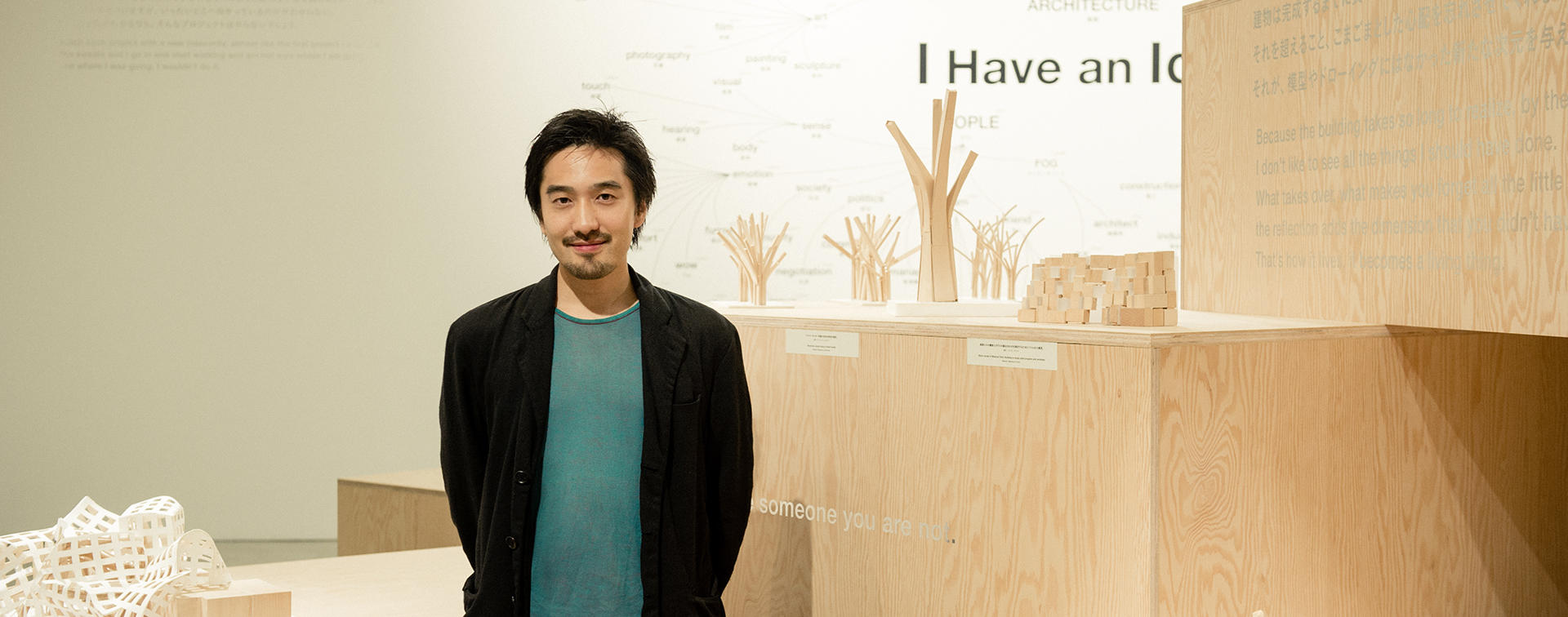
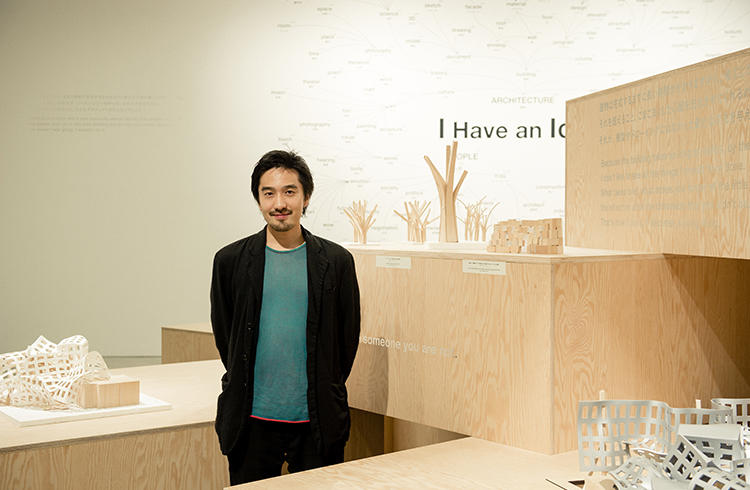
Excavating the past to create gathering place
Giving form to memories through maps, words, and images
Tane is a co-founder of DGT Architects, a Paris-based architecture firm which undertakes many projects around the world. DGT was a finalist in the design competition for Japan's new national stadium. The firm also designed the Estonian National Museum currently under construction. Tane was director for the "Architect Frank Gehry 'I Have an Idea'" which began October 16 at 21_21 DESIGN SIGHT. We asked him about his ideas to attract more people to Roppongi.
Blending the past and future in today's streets
I think the key to creating a gathering place is to mix the past and future of a locality. In Roppongi for example, you need to think about how people have used this area up till now, and how it is going to be used in the future. There is the invisible past and the invisible future and you need to combine the two. In recent years, town development has basically meant creating shopping areas, and that is why places such as Aoyama, Shibuya and Roppongi tend to look all the same. I believe the best way to prevent places from looking identical is to study the culture and history of each place. The more you know about the history of a place, the more potential you can bring out of it, and the more likely it is to thrive in the future.
Cities are overflowing with information about the past. The very spot you are standing in could have been the former site of a samurai residence. Or another spot might be where someone was killed, or where important encounters between people took place. If you draw a rough map of Tokyo Midtown for example, drawing in the architecture that used to be here, you can begin to see images - such as footsteps on the ground or a room where someone is sleeping. All the faded memories come back, and can be added to the pile of data. Maybe instead of photographs, you can be more abstract and use maps and words and shadows.
The data does not belong to just one layer, but many layers. So you begin to see the layers superimposed on each other: Roppongi as it was 50 years ago, or Roppongi in the Edo period, and so on. Using projection mapping, you could project images of the people of the past and have the images mingle with actual people walking the night streets of Roppongi. The projection mapping could be programmed so that the images gradually trace our history back to the earliest times. Maybe the images could be projected in different areas of perhaps the flow of people could move differently at times.
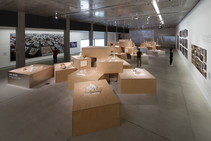
Architect Frank Gehry "I Have an Idea" exhibition
An exhibition focusing on the ideas of Frank Gehry, a world renowned architect who has designed many stunning works such as the Guggenheim Museum Bilbao. The exhibition features a "Gehry Room" modeled after the meeting room in Gehry's office and a "Development of ideas" section, with nearly 90 items including models, photographs, and sketches on display. There are also visual explanations of Gehry's representative works and of the latest technology in architecture. Held until Feb. 7 (Sun) 2016 at 21_21 DESIGN SIGHT.

Gehry's manifesto which Tane mentioned in the interview. A Japanese translation is also on display at the exhibition.
Searching data as if digging for ancient remains
Since setting up our office, I've been doing architectural work, but it's only recently that I've discovered the importance of the memories of places; it's finally dawned on me that this is a theme I can work on for the rest of my life. I think I'm interested in the memories of places because it's important for me to have plenty of information. We live in the information age and there has been the development of the Internet; I think the human brain needs all this massive data in order to evolve.
Architects do research every day to increase the amount of information they have about a place - it's a process that's necessary in order to understand the past. I think architects feel the need to collect the data on people of all types and races who have lived before us.
It's like excavating at a site of ancient ruins. As you dig the ground, you find stones and bits of earthenware - proof that there was life in a place. You might also say it's like investigating the scene of a murder. (laughs) There are traces left by the criminal which may or may not be vital. But you investigate everything that seems suspicious and at some point, something becomes clear and you are led to the suspect. In doing my work, there are many cases where I get a concept for architecture after doing a lot of editing on the information I've accumulated on a daily basis.
Architectural works based on a deep philosophy
I began taking this kind of approach after entering the competition in 2006 for the Estonian National Museum project. The plan for the museum is called "Memory Field" which refers to the memories of the place or how the place originally looked. The site of the museum in Estonia used to be the runway of the Soviet military airfield. It's a negative legacy but our aim is to change it into something positive so that the people of Estonia can confirm their national identity and create a new future.
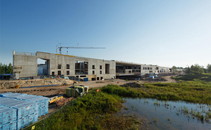
Estonian National Museum
In 2006, Estonia held a design competition for the Estonian National Museum as a national project marking the country's 15th anniversary of independence. The competition was won by DGT Architects. The new museum is being constructed on what used to be a runway of a Soviet military airfield. Construction is scheduled to be completed in 2016.
To be honest, I used to be uncertain about architecture; I wasn't sure whether it is about design or art, but after winning the design competition for the Estonian museum, I was forced to ask myself questions and I realized that the memories of a place can become the theme for architecture.
I think architects needs to have a big vision. They need to carefully contemplate things and give expression to things like history and culture. As is the case with Frank Gehry, the power of architects is that they can make works based on a deep philosophy which will transcend time and continue through future generations. Nowadays, it's possible for designers to design homes and artists to make buildings, and I think we have come to a stage where architects are being called to do their part as architecture professionals.

The "I Have an Idea" concept for the Franke Gehry exhibition
For the "Architect Frank Gehry 'I Have an Idea'" exhibition, we visited Frank at his office in Los Angeles. In the middle of our conversation, Frank suddenly asked us if we knew his manifesto.
Frank's manifesto starts out like this: "So you got an idea. A stupid idea but you like it. So you look at it till you don't like it. So then you make another model as another way of looking at the first stupid idea; and you like it but only for a little while." I was so impressed. We put up this manifesto in the Gehry Room at the exhibition. I thought it was well-known, but even Frank's staff said they hadn't known. Apparently Frank used it a few times in his speeches.
"Frank Gehry" exhibition
A retrospective exhibition held at the Pompidou Center in Paris from October 2014 to January 2015. Divided into six sections showing the various stages of Frank Gehry's work, numerous representative works of each era were shown, giving visitors a detailed view of the evolution of his architecture.
That's how I decided to have "I have an idea" as the concept for the exhibition. My decision was cemented after visiting two exhibitions on Frank Gehry. One was a large-scale retrospective held in Paris at the Pompidou Center and the other was the "Louis Vuitton Foundation:Building in Paris by Frank Gehry" exhibition that is still being held at Espace Louis Vuitton Tokyo. I felt that the two exhibitions gave me the liberty to hold a very different kind of exhibition.
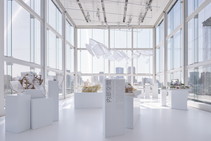
"Louis Vuitton Foundation:Building in Paris by Frank Gehry" exhibition
An exhibition on the Louis Vuitton Foundation's contemporary art museum, designed by Frank Gehry, which opened in Paris in October 2014. Visitors are invited to see how construction work was made on the innovative building with its huge swirling glass panels. The exhibition will be held until Jan. 31 (Sun) 2016 at Espace Louis Vuitton Tokyo. ©LOUIS VUITTON / YASUHIRO TAKAGI
An exhibition about architectural ideas
The venue for the exhibition is 21_21 DESIGN SIGHT, a place that informs visitors - men, women, young and old - about the value of designs. Frank Gehry is a brilliant architect and creative genius, but I thought of showing him as a person - a person who enjoys sailing in the sea on the weekends, who loves hockey, reads Shakespeare and Kawabata Yasunari and is enthusiastic about the traditional arts. I wanted to show everybody the kind of things which interest Frank and pique his curiosity.
We displayed a lot of Frank's architectural models, but we didn't show any architectural plans or specific information regarding the site of the buildings - we did away with all the data. When you put all the architectural details like functions and regulations aside, what remains are Frank's ideas, and these ideas are expressed in his models and sketches and in his words. It's not at all like the usual architectural exhibition, and maybe people are going to have complaints, but I will have to tell them that this is essentially an exhibition about ideas.
While the exhibition introduces Frank Gehry, it's also about the importance of ideas. In the director's message, I wrote that the age of ideas has begun. I went to look at Frank's works again such as the Guggenheim Museum Bilbao and I was moved to see how magnificent architecture can be. Making architecture is a very positive thing; you can't come up with ideas for architecture unless you have strong hopes for the future. By presenting Frank Gehry, I wanted to send out the message that ideas can change the times we live in - they can change the world.
Architecture, theater, and exhibitions
I design for theaters and exhibitions and I'm often questioned about the differences between those genres and architecture. But there is no difference in that sense that in every genre, I'm thinking and giving expression to my thoughts. I did work in the theater at the beginning of my career, and what I learnt from that is that it's impossible to separate time and space. When doing architectural work, people tend to pay most of their attention to space, but I think about both time and space. And for me, the weight of space and time are different.
A theatrical performance ends in an hour, and an exhibition lasts a few months. In contrast, architecture exists for 20 years or 50 years or a century. A play in a theater is short-lived but it's an event with a festive mood with perhaps a thousand people sharing the same space. But a theater would be a cumbersome thing if it were sitting in everyday architecture. At an exhibition I once worked on, there were 70,000 visitors in a span of two weeks. If a four-member household were to use a house 70,000 times, it would take about 50 years. In other words, time spent in architecture is stretched very long while time spent in theaters and exhibitions is very tightly compressed. That's the view I've come to take.
Whatever the genre I work in, it's all the same for me in that I always think about time and space or about place and memories. With an exhibition, the venue may not have significance, but the items that are placed there have meaning, so I think about the items and memories. When asked to do a project, I just try to do my best; I don't give much thought to genres and categories.
But my experience in theater design has made me conscious of the effect that visitors have on each other; visitors are like performers in that they too are watched by other visitors, so I think about that when doing work for exhibitions. When someone intently looks at something, other people become interested and come over to look. When people simultaneously look at the same thing, hopefully, they will find new ways of looking at it.
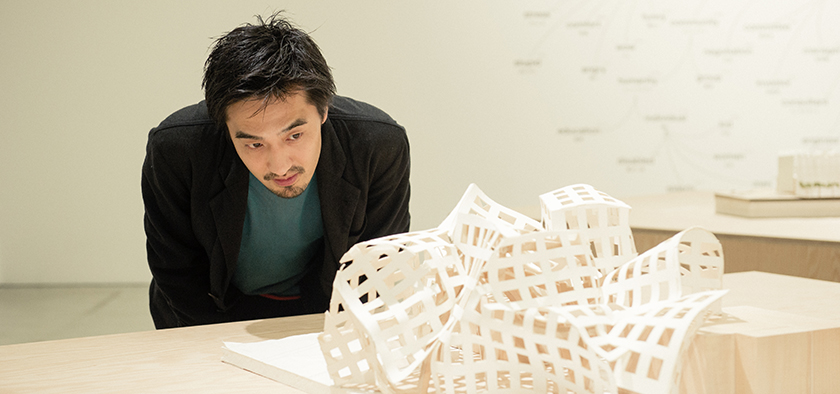
Art that is wrapped up in commercialism
I've lived in Japan, Sweden, Denmark, Britain and France; inevitably there are both things I like and dislike about each place. I've lived in Paris for such a long time now and my feelings toward the city have gone beyond like or dislike to an almost love-hate level. I sometimes get annoyed by trivial things such as the dirty underground train or bad manners. But then Paris has such history and culture and its streets are truly beautiful, and sometimes I come across special places which I would not encounter in any other city.
I guess this is human nature but having lived in different places, I can't help comparing them and nitpicking. Of course, I really like Tokyo and I enjoy myself here, but at the same time, there seems to be such a strong consumer culture with too much emphasis on pleasure; people seem to have lost sight of the important things and I think that's a pity. There's not much greenery in Tokyo and the trains are crowded, and the day-to-day life is really tough here. (laughs)
In addition to art museums, Roppongi has the AXIS facility and the art galleries, and this is the best place in Japan for design and art. It would be better though, if culture and commercialism could blend and become one, and overflow into the streets. The ideal would be for commercialism to produce culture and not for culture to be eaten up by commerce. Events like "DESIGN TOUCH" are good, but once these events are over, design and art all packed up in the shops and art museums again -put back into safe boxes. It still seems as if culture is wrapped up in commercialism.
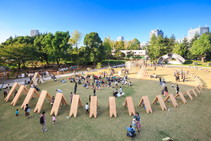
Tokyo Midtown DESIGN TOUCH 2015
Tokyo Midtown DESIGN TOUCH is an annual event that started in 2007 on the concept of "enjoying designs by using the five senses". At the 2015 event, there were installations such as "Wooden Block Square" by Kengo Kuma and the "MUJI HUT" which showed how a simple way of living is possible in a hut, and an open-air class dubbed "School in the Forest by 'Roppongi Future Talks'".
Making art more accessible to people in everyday life
In Paris, many kinds of events are produced such as sending musicians to perform at subway stations, and culture is continually being created. In Roppongi, there are some wonderful pieces of art when you come up to the ground level from the Oedo subway line, but there's a tendency to protect these artworks from the public - drawing lines and keeping them as it were, in boxes.
At the Frank Gehry exhibition I directed, I protested against putting up fences to protect the items on display - I did quite a lot of fighting. (laughs) "I said, 'Let's set the right tone for this exhibition and let's trust the visitors.'" In Europe, people are educated in early childhood about how to looking at and appreciate art and they know how to enjoy culture. So there are few cases of mischief or items being broken.
I suppose there are too many boxes in Roppongi because there are so many art pieces here. I think if more works of art and design were placed in the open where people could touch them and appreciate them in everyday life, Roppongi will be able to attract even more visitors. I'm sure it could become an area with worldwide appeal.
What the word "future" points to
I did not ponder much about the future before, but having participated in the design competition for the new national stadium and seeing the stadium issue unfold, I've begun to think about the future a lot. The word "future" ("mirai in Japanese) is made up of the character "mi" which means not yet, and "rai" which means come. We have dreams and hopes for the future because the future doesn't come. It doesn't show up and that's why we make an effort and strive. I think the "future" is a word we need to keep reaching for our big dreams and it's also a word that points to the time we spend trying.
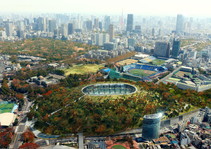
"Kofun Stadium" plan for the New National Stadium
At the "International design competition for the New National Stadium of Japan 2020", DKT Architects (comprising Tane and two other architects) was among the 11 finalists, alongside Zaha Hadid Architects which won the competition. DKT's plan for the Tokyo Olympics 2020 stadium was shaped like a "kofun" (an ancient Japanese tomb) with grass and trees growing on the roof.
So the future is something that never ever comes. (laughs) At the moment, Tokyo probably thinks of the future as being 2020 but the future is not the Tokyo Olympics. We must have fortitude and try not to be deceived by the year 2020. Otherwise the moment the Olympics are over, we are going to stumble. I think we - and that includes people of my generation - need to get a grip on ourselves and be steadfast.
Editor's thoughts
Tane-san talked about past and future and time and space. When we later asked him to give us the name of one book which inspires his creativity, his reply was "Momo" by Michael Ende. The novel is about the little girl Momo who takes back the time stolen by the time-thieves. Time is clearly an important theme for Tane-san. We hope to write about the book in our blog in the future.
http://6mirai.tokyo-midtown.com/blog/book/ (Japanese version only)
(edit_kentaro inoue)




